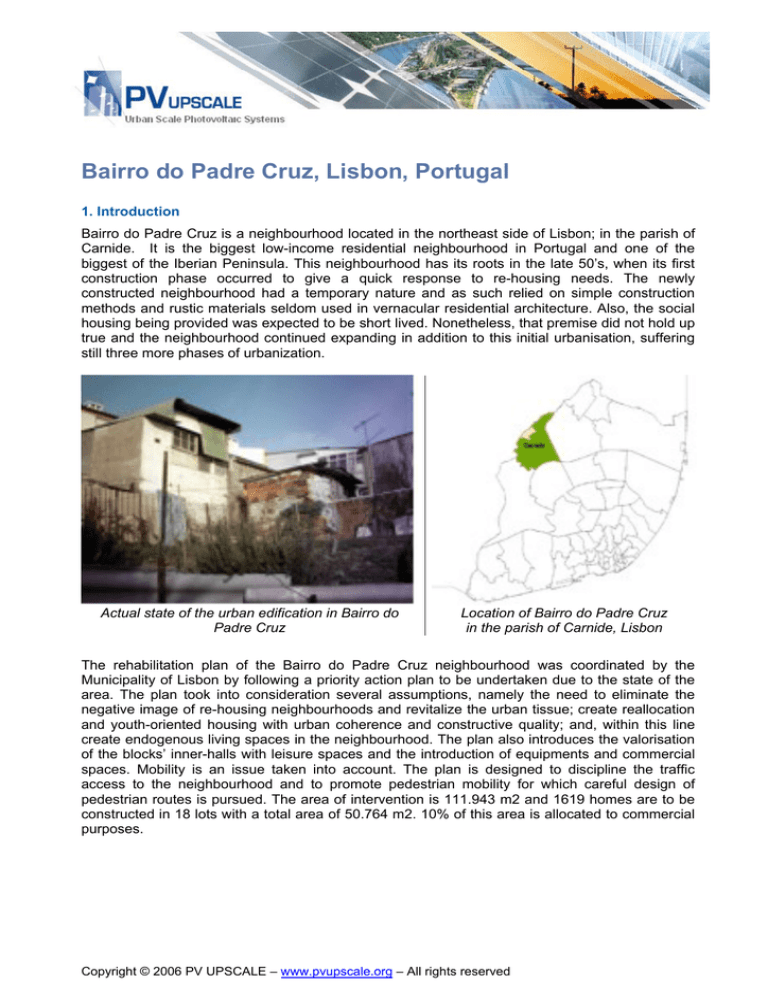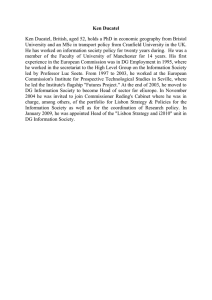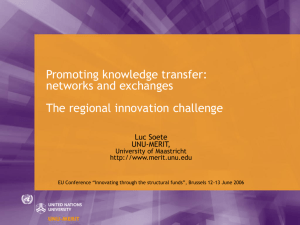
Bairro do Padre Cruz, Lisbon, Portugal
1. Introduction
Bairro do Padre Cruz is a neighbourhood located in the northeast side of Lisbon; in the parish of
Carnide. It is the biggest low-income residential neighbourhood in Portugal and one of the
biggest of the Iberian Peninsula. This neighbourhood has its roots in the late 50’s, when its first
construction phase occurred to give a quick response to re-housing needs. The newly
constructed neighbourhood had a temporary nature and as such relied on simple construction
methods and rustic materials seldom used in vernacular residential architecture. Also, the social
housing being provided was expected to be short lived. Nonetheless, that premise did not hold up
true and the neighbourhood continued expanding in addition to this initial urbanisation, suffering
still three more phases of urbanization.
Actual state of the urban edification in Bairro do
Padre Cruz
Location of Bairro do Padre Cruz
in the parish of Carnide, Lisbon
The rehabilitation plan of the Bairro do Padre Cruz neighbourhood was coordinated by the
Municipality of Lisbon by following a priority action plan to be undertaken due to the state of the
area. The plan took into consideration several assumptions, namely the need to eliminate the
negative image of re-housing neighbourhoods and revitalize the urban tissue; create reallocation
and youth-oriented housing with urban coherence and constructive quality; and, within this line
create endogenous living spaces in the neighbourhood. The plan also introduces the valorisation
of the blocks’ inner-halls with leisure spaces and the introduction of equipments and commercial
spaces. Mobility is an issue taken into account. The plan is designed to discipline the traffic
access to the neighbourhood and to promote pedestrian mobility for which careful design of
pedestrian routes is pursued. The area of intervention is 111.943 m2 and 1619 homes are to be
constructed in 18 lots with a total area of 50.764 m2. 10% of this area is allocated to commercial
purposes.
Copyright © 2006 PV UPSCALE – www.pvupscale.org – All rights reserved
2. The Lisbon Ideas Challenge
The Lisbon Ideas Challenge is an international design competition initiated by PV Portuguese
experts from the Centre for Innovation, Technology and Policy Research, IN+, at Instituto
Superior Técnico, Technical University of Lisbon involved in the IEA-PVPS-Task 10 which aims at
fostering and promoting PV deployment in urban areas. Following a first edition of the
competition, which called for ideas for urban structures integrating PV, the organizers of the
competition decided to turn this initiative into a more inclusive project for Lisbon and promote the
integration of PV in one of the most relevant low-income neighbourhoods in Portugal. The
motivation was to ally PV dissemination with the possibility to create the first solar neighbourhood
in Lisbon.
The 2nd Lisbon Ideas Challenge aimed at promoting the presentation of ideas of well integrated
and well-designed urban renovation/rehabilitation plans for the transformation of a low-income
residential neighbourhood of Lisbon into a Solar Neighbourhood.
2nd Lisbon Ideas Challenge intervention Area in
Bairro do Padre Cruz
Site plan of the rehabilitation of Bairro do
Padre Cruz
This Solar Neighbourhood’s intent is to serve the triple purpose of technological demonstration
site, pro-active dissemination and education, targeting several stakeholders, from the local
community to public authorities, passing through energy services companies.
As Portugal is one of the European countries with lowest PV capacity installed, mainly due to lack
of proper governmental incentives and complex administrative procedures, the most important
question was to get the attention and cooperation of the Lisbon Municipality. For this, the first
step was to involve National Energy Agency, ADENE, who supported the project from the very
beginning, as well as the Lisbon's Municipal Energy-Environment Agency, Lisboa E-Nova, who is
the direct link to the Lisbon Municipality.
Finally, from the already existing plan developed by the Empresa Pública de Urbanização de
Lisboa (EPUL), the Municipality of Lisbon assisted by several organisms, decided to boost this
renovation project and invited the international community of architects, designers and engineers
to present proposals of integrated renovation/rehabilitation programmes of urban intervention that
valorise the area and transform this neighbourhood into a 1 MWp solar neighbourhood. the
Centre for Innovation, Technology and Policy Research, IN+, at Instituto Superior Técnico,
Copyright © 2006 PV UPSCALE – www.pvupscale.org – All rights reserved
Technical University of Lisbon in straight cooperation with the National Energy Agency, ADENE
and the Lisbon's Municipal Energy-Environment Agency, Lisboa E-Nova,
Competitors were requested to present intervention ideas for urban renovation and rehabilitation
plans for one commercial building, a kindergarten and a social housing apartment block of the
low-income residential neighbourhood of Lisbon, Bairro do Padre Cruz, Carnide. They were
asked to take into account the three following factors:
•
Integration : PV materials should be adequately integrated in the urban-scale design
concept, both physically and aesthetically. The level of integration should be explicitly
stated in the design description, as well as the identification of functional added values of
the PV materials,
•
New applications or technological concepts : Entries should attempt to make use of
PV materials in innovative ways, both regarding conventional and new technological
concepts,
•
Communication : The use of well-integrated PV materials should be explicit and
therefore easily communicate with the general public
The objective of the 2nd Lisbon Ideas Challenge was to turn transformation of a
low-income residential neighbourhood of Lisbon into a 1 MWp Solar
Neighbourhood.
Competitors were requested to present intervention ideas for urban renovation
and rehabilitation plans for :
•
one commercial building
•
a kindergarten
•
a social housing apartment block
The Lisbon Municipality hopes to adopt and effectively implement the winning
entries.
Commercial Building
The commercial building is a shopping centre with a rectangular shape and an open space in the
middle. The commercial building can integrate PV materials in the South, East and West facades
and also in the flat roof cover. Solutions combining PV properties of shadowing effects and
natural lightning functions were presented both for the roof and the facades.
The commercial building that won the 2nd Lisbon Ideas Challenge 1st prize was Shopping
Delight. The concept follows an orthogonal grid plan similar to downtown Lisbon where blocks
become shops and streets circulation space. A glass facade interrupts the shops allowing natural
light in and views out. PV materials constitute the commercial building rooftops; a non-innovative
approach that allies natural light with shadowing effects, forming shopping galleries. The North
façade is covered with vegetation, hanging gardens, allying the PV integration strategy with other
forms of expressing sustainability issues and possibilities.
Copyright © 2006 PV UPSCALE – www.pvupscale.org – All rights reserved
Solutions to the commercial building
Public Spaces: Kindergarten
The kindergarten is the most important public outdoor space in this block. It is intended to be a
leisure area with special attention given to the possibility of integrating urban art aimed at
increasing awareness of the technology among the community. In this public space the solutions
presented covered a wide variety of structures from esplanades that ally PV panels with
shadowing panels, to kiosks and lamps and innovative playgrounds integrating PV materials.
Solutions for the kindergarten
The public space is fulfilled with Photovoltaic-flowers, PV-systems designed as relatives of plants,
conceiving a strategy to catch a maximum of sun energy while consuming a minimum of
materials. Being a moving structure, adaptable to the sun, it communicates a relation with it and
Copyright © 2006 PV UPSCALE – www.pvupscale.org – All rights reserved
an energy dependency. Besides the electricity generation, PV –Flowers develop more functions
in the urban space, working like parasols. Technically the panels green color might be satisfied
using thin film technology, semi transparent, dealing with both energy production and shadowing
effects. Being a self-standing structure, possible vandalism issues would also have to be
considered, as well as the connection to the main network. Even so, the structures are designed
to close themselves in conditions of darkness or bad weather. Considering all the kindergarten
area, 78 m2 of PV surface would be installed.
Social Housing
The social housing apartment blocks under consideration were to be sustainable massproduction houses, including PV as part of a wider strategy. The block facing south is the bestoriented building in the whole intervention area. The building front faces one of the
neighbourhood’s main streets, while the rear faces the kinder garden. The blocks will be 6storeys high, providing 10 or 28 apartments. Being the best south oriented building under
competition this housing block presents the possibility to integrate PV in the facades, covering
balconies, shadowing devices to protect windows, or covering whole facades to provide natural
light, same happening in the block’s flat roof, where it can be used as a skylight.
Solution to the residential block
The winning project for the social housing was PV Tile. The main idea is to create an object that
can be applied to existing buildings, renovations, or to new constructions. The Urban Tile is a
photovoltaic object inspired by Portuguese tiles where a three dimensional component has been
added. Designed to be facing the best solar orientation optimizing solar gains and electricity
production, the Urban Tile is designed to be 0.2 m2, a smaller PV surface breaking down the
scale of standard PV panels, therefore becoming more versatile to integrate in buildings. The
social housing building under competition is to integrate 118 PV Tile units, 5,400 m2 Urban Tile in
the building South façade.
Copyright © 2006 PV UPSCALE – www.pvupscale.org – All rights reserved
This project, housing PV tile, effectively responds to the purpose of the competition. Aimed at
new housing concepts and refurbished buildings, the piece design is presented as an innovative
and feasible product, considering the built environment for which is aimed at. Technically some
issues have to be dealt with, namely the wiring system that might be complex, involving electrical
losses and high installation costs. Also the overall maintenance cost of the building, the insulation
of the building envelope and the vandalism constraints must be analyzed when considering the
product development. Regarding the building conception, and not the piece itself, the achieved
result evidences a good integration, despite the fact that the tile density on the top of the building
is high and could cause shadowing effects between tiles.
3. Summary of problems, barriers, solutions and recommendations
How to get local decision makers to study the possibility of building a solar district?
Portugal is one of the European countries with the lowest PV capacity installed, mainly due to
lack of proper governmental incentives and complex administrative procedures. Thus, PV is
generally not seen as an energy option for buildings or for cities. Making international teams
study the possibility to design a solar district in Portugal with the support of the Lisbon
Municipality was therefore seen as hardly possible!
In order to get the attention and cooperation of the Lisbon Municipality, Portuguese PV experts
benefited from the technical support of a programme of the International Energy Agency, the
Photovoltaic Power Systems Programme, to initiate an international competition to design a
1MWp solar district in Lisbon, the 2nd Lisbon Ideas Challenge. This initiative was so successful
that the Lisbon Municipality claimed to be willing to adopt and effectively implement the winning
entries of this competition.
How to finance the construction of a 1 MWp solar district without any proper national
incentives?
The project overall costs and business models have still not been developed. Despite that,
several options are open and available for discussion, namely the ownership and maintenance
responsibility of the systems and the legal framework to apply.
One of the possibilities is that the over cost caused by the integration of the PV panels in the
neighbourhood is supported by the municipality in partnership with the utilities and regional and
local energy agencies, in a clear action of enhancing, setting the example and fostering a new
energy market that is beginning to rise. Being the owner of the system the municipality would also
be the entity benefiting from the actual feed in tariff incentive scheme offered by the Portuguese
legislation, what would allow the possibility to promote and set the example as an early investor in
the green electricity market.
One other option is for the construction company to provide the investment and be the owner of
the system and the responsible entity for its production and maintenance, exploring the system
during its lifetime.
The development of this project can thus be an added value in both directions, the PV sector
through the possibility to enter the independent power producer market in a more appealing way
and the city by the sustainability and innovation image associated to the municipality.
Copyright © 2006 PV UPSCALE – www.pvupscale.org – All rights reserved
4. Sources of further information
•
•
•
www.lisbonideaschallenge.com.pt
www.iea-pvps-task10.org
http://in3.dem.ist.utl.pt/
Case Study prepared by:
Joana Fernandes of Lisboa e-nova
e-mail: joanafernandes@lisboaenova.org
Photo credits: Photograph 1,2 and 3 © Relatório Social do Bairro do Padre Cruz
Photograph 4 © Empresa Pública de Urbanização de Lisboa (EPUL)
Photograph 5,6 an 7 © Lisbon Ideas Challenge
Copyright © 2006 PV UPSCALE – www.pvupscale.org – All rights reserved






